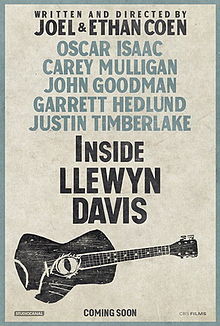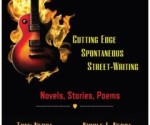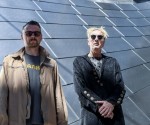The Coen Brothers Discuss their New Film Inside Llewyn Davis
 Inside Llewyn Davis, the new film by Academy Award Winners Joel and Ethan Coen, follows a week in the life of a young folk singer at the crossroads, struggling to make it in the Greenwich Village folk scene of 1961. The singer, played by Oscar Isaac with his guitar in tow, huddled against the unforgiving New York winter, is beset by seemingly insurmountable obstacles, some of them of his own making. Living at the mercy of both friends and strangers, scaring up what work he can find, Llewyn Davis journeys from the baskethouses of the Village to an empty Chicago club – on a misbegotten odyssey to audition for a music mogul and back again. The movie also stars Justin Timberlake, Carey Mulligan and John Goodman and was screened at this year’s New York Film Festival, which this film proves it to be one of the best film fests in recent years. I had the chance to talk with both writers/editors/directors Joel and Ethan Coen about the film.
Inside Llewyn Davis, the new film by Academy Award Winners Joel and Ethan Coen, follows a week in the life of a young folk singer at the crossroads, struggling to make it in the Greenwich Village folk scene of 1961. The singer, played by Oscar Isaac with his guitar in tow, huddled against the unforgiving New York winter, is beset by seemingly insurmountable obstacles, some of them of his own making. Living at the mercy of both friends and strangers, scaring up what work he can find, Llewyn Davis journeys from the baskethouses of the Village to an empty Chicago club – on a misbegotten odyssey to audition for a music mogul and back again. The movie also stars Justin Timberlake, Carey Mulligan and John Goodman and was screened at this year’s New York Film Festival, which this film proves it to be one of the best film fests in recent years. I had the chance to talk with both writers/editors/directors Joel and Ethan Coen about the film.
The look, as always, is so interesting. You still shoot on film?
Joel Coen: The early idea we had was to start the movie in black & white. So we sat down with the director of cinematography Bruno Delbonnel. We were trying to figure these things out so we broke the script down and then we realized we needed to shoot it in color. It’s hard for us to imagine the story in abstracts. A s we started to break down the movie by specific shots we realized we could not do that.
Ethan Coen: The first shot was a very long hand-held camera in the very beginning. We wanted a slushy-grainy-New York- monosaturated look taken from verite. The movie was shot on film and Bruno had not used a digital camera. I am glad we shot on film, of course. There’s something better when it’s shot on film. We use computers after we shoot so it all gets manipulated.
What did you do to prepare for this movie, research wise, given that it’s historical in nature?
Joel Coen: We read books about the 60’s and really researched the folk scene. We bought a number of books and memoirs and listened to the music, so that got us going. We were always interested in the music of the period — the so called folk revival of the late 1950’s. The thriving folk music scene that was taking place in the village before Dylan showed up. Music that was being produced and played during what might have been termed the Beatnik scene of the 50′s and early 60’s. That period lasted only through the very early 60’s and most people don’t even know about it. People know much more about Dylan — his story, his music — than about this period because he was such an important and transformative figure. He arrived in 1961 and changed everything.
Ethan Coen: We don’t pick subjects, we don’t do that. We just have possible ideas, very vague, that turn into a conversation then becomes progressively more concrete. We looked at variety shows from the time and read Dylan’s memoir. The movies about achieving success have been made and are less interesting. Doing a movie where the protagonist does not find success seem much more interesting. Folk music is a big subject, it was the cultural Dylan moment and we thought about doing something before Dylan showed up and changed everything. Dylan was a catalyst and an obsession with both of us and I find it interesting with ironic repercussions. It’s a big subject. Folk music is a big subject. We create this character who seems tortured with his relationship to success –the guitarist’s tortured relationship to success.
T-Bone Burnett is involved. Tell me about him. I see this will be your fourth collaboration.
Joel Coen: T-Bone is part of the mix from the beginning, when we started to write the script and we really didn’t know specifically what the music was going to be – we just knew that there was going to be a character that played something. A lot of what we decide and then write in the screenplay comes directly from talking to him and from the three of us tossing out ideas.
So you collaborate on everything and start only with a general idea?
Ethan Coen: We never, including on this movie, do an outline or figure out what’s going to happen, how the screenplay’s going to unfold. We just start writing with the first scene in and see where it goes. We always wanted to work with T-Bone on this. A couple of the songs were in the script and T-Bone was the first person we sent the script to. We weren’t really thinking about the music so much.
Joel Coen: In this case though, we did know how we wanted to end it.
The Upper West Side and the Beacon Theater are wonderful locations you used. Any obstacles shooting?
Ethan Coen: Spring came early — we were fighting it. Then we had to shoot a winter scene in the village and the trees had already started blooming. Weather is a part of the look so we had to bring in snow.
Inside Llewyn Davis is in select theaters nationwide on December 6. For more information, please visit http://www.insidellewyndavis.com.










